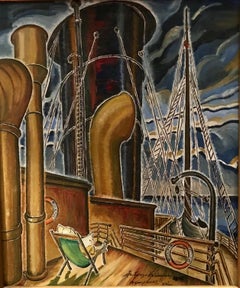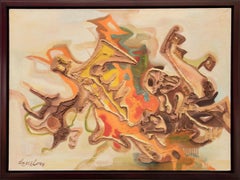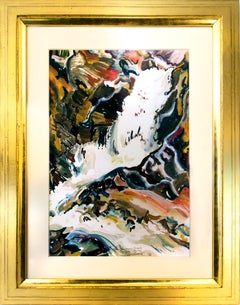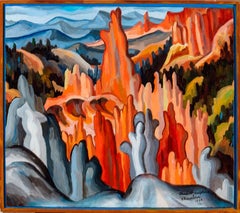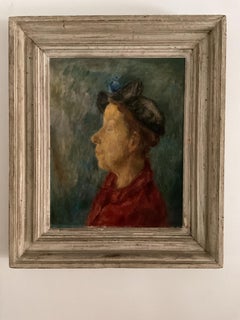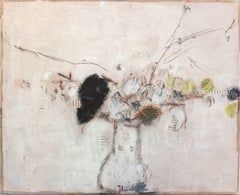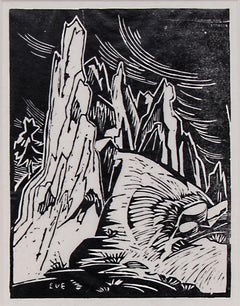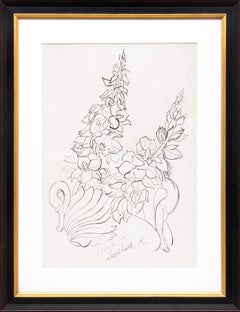Eve Drewelowe Art
American, 1899-1989
From her earliest memory, Eve Drewelowe wanted to be an artist, and she became the first student to receive a masters of fine arts from the University of Iowa. After graduation, she went with her new husband to Boulder, Colorado, where she soon found herself in the role of dean’s wife. Eventually that responsibility and its “chores” proved to be too restrictive. After a health crisis, Drewelowe had a self-described “reincarnation” in which she resolved to make a place for her creativity. Naturally effusive, she yet valued being alone, and her strong feelings for life were expressed in her exuberant paintings. Growing up on an Iowa farm, Drewelowe developed a love for the land from her “environmentalist” father, who died when she was eleven. Subsequently, The Dean of the Graduate School at Iowa served as a father-figure when he facilitated her entry into the graduate program in art. Seemingly skeptical, Carl Seashore secretly wanted the young woman to “establish a first in the history of art training across the nation,” as the artist would later reminisce. Drewelowe graduated in 1924, and she later was a benefactor of what became one of the nation’s leading college art programs.
At college, Drewelowe met and married a political science student, Jacob van Ek. Accepting a teaching position at the University of Colorado, van Ek moved to Boulder with his bride, who pursued her interest by helping found the Boulder Artists’ Guild. In 1928-1929, they traveled around the world to twenty-three countries for thirteen months, during which Drewelowe filled seven sketchbooks. With her husband now a dean, she threw herself into remodeling their house, a domestically acceptable creative project. Balancing her art and her duties as a dean’s wife, Drewelowe felt increasing frustration, and her health began to suffer. In the catalogue of a 1988 retrospective, she gave voice to her desire for self-determination: “Housewife! What an odious word! First! Foremost! Always! My waking thought from an embryo was on my need to be an artist!” Traveling to New York for her second solo exhibition in 1940, she stopped at the Mayo Clinic, where she was diagnosed as having a gastric polyp. This experience led to a new dedication to her painting, a complete turnaround in which she called her “reincarnation.” Inspired by the Rocky Mountains, she painted animated landscapes that pulsated with energy -- as if still in motion from generative forces. With a rainbow palette, Drewelowe created visionary scenes by intensifying colors in lively, rippling patterns.
©David Cook Galleries, LLCto
2
1
1
1
1
Overall Width
to
Overall Height
to
4
2
1
2
1
2
2
1
1
1
4
3
1
1
1
4
9,081
2,808
2,504
1,349
4
2
4
Artist: Eve Drewelowe
"Arcturus, Helsing" Modern Oil Painting WPA American Scene Denver Historical Art
By Eve Drewelowe
Located in New York, NY
"Arcturus, Helsingfors," 19 x 16 inches, oil on canvas, signed, titled and dated 1935, 33/30C lower right.
Provenance: Acquired from the personal collection of Jim Elkind (Lost City Arts) who acquired it from interior designer Jay Spector. Graham Gallery label on verso.
Born in New Hampton, Iowa, Eve Drewelowe graduated from Hampton High School in 1919 and then studied at the University of Iowa...
Category
1930s American Modern Eve Drewelowe Art
Materials
Oil
Alpha – The Beginning by Eve Drewelowe, 1950s Mid-Century Modern Abstract
By Eve Drewelowe
Located in Denver, CO
“Alpha – The Beginning” is a vibrant and expressive 1950s abstract oil painting by renowned Colorado modernist Eve Drewelowe (1899–1989). This dynamic mid-century modern composition ...
Category
Mid-20th Century Abstract Eve Drewelowe Art
Materials
Mixed Media, Oil
$1,795 Sale Price
72% Off
Modernist 1945 Abstract Waterfall Watercolor Landscape Painting by Eve Drewelowe
By Eve Drewelowe
Located in Denver, CO
This striking 1945 abstract landscape watercolor by pioneering modernist artist Eve (Van Ek) Drewelowe, titled "The Champagne Cascades, Crescendos, Crashes," is a bold interpretation...
Category
1940s American Modern Eve Drewelowe Art
Materials
Watercolor
$13,500 Sale Price
22% Off
"Stardust Sculpture" (Little Bryce, Utah)
By Eve Drewelowe
Located in Lambertville, NJ
Jim's of Lambertville Fine Art Gallery is proud to present this piece by Eve Drewelowe (1899 - 1988).
Landscape painter, Eve Drewelowe, was the eighth of thirteen children born in ...
Category
1930s Eve Drewelowe Art
Materials
Oil, Board
Related Items
Rare New York City Oil Portrait by Modernist Artist Lisa Mangor, ca 1940’s
Located in Baltimore, MD
This is a highly stylized portrait of a lady by known and listed artist Lisa Mangor. Ms.Mangor was born in Russia in 1890 and came to New York likely around the beginning of World W...
Category
1940s American Modern Eve Drewelowe Art
Materials
Oil
$788 Sale Price
20% Off
H 28 in W 24 in D 3 in
AWH 163 - Original Figurative Abstract Still Life Soothing Floral Oil Painting
By Bernhard Zimmer
Located in Los Angeles, CA
Bernhard Zimmer has created a positive stir at major international art fairs (Art Basel, Kunst Köln, etc.). His lively and mysterious compositions pique the taste of the serious art ...
Category
21st Century and Contemporary Abstract Eve Drewelowe Art
Materials
Canvas, Oil Pastel, Mixed Media, Oil
$3,600
H 35 in W 43 in D 1 in
Three Young Men
By Vito Tomasello
Located in Wilton Manors, FL
Beautiful ca. 1960 portrait by American artist, Vito Tomasello. Oil on sized illustration board measuring 21.5 x 30 inches. Signed lower right.
A lifetime NYC resident, Tomasello ...
Category
Mid-20th Century Abstract Eve Drewelowe Art
Materials
Oil, Board
Woman and Child in the Woods - Midcentury Abstracted Landscape in Oil on Canvas
Located in Soquel, CA
Woman and Child in the Woods - Midcentury Abstracted Landscape in Oil on Canvas
Dramatic abstracted painting of a woman holding a child in the woods by Maley (20th Century). This pi...
Category
1970s American Modern Eve Drewelowe Art
Materials
Canvas, Oil, Stretcher Bars
$2,500
H 26.5 in W 21 in D 1 in
AWH 165 - Original Figurative Abstract Neutral Soothing Still Life Oil Painting
By Bernhard Zimmer
Located in Los Angeles, CA
Bernhard Zimmer has created a positive stir at major international art fairs (Art Basel, Kunst Köln, etc.). His lively and mysterious compositions pique the taste of the serious art ...
Category
21st Century and Contemporary Abstract Eve Drewelowe Art
Materials
Canvas, Mixed Media, Oil
Bernhard ZimmerAWH 165 - Original Figurative Abstract Neutral Soothing Still Life Oil Painting, 2017
$2,625
H 24 in W 32 in D 1 in
Early Modern American Portrait, Pennsylvania/Massachusetts, Frank Anderson Trapp
Located in Baltimore, MD
This is a very stylized and powerful portrait by the noted artist Frank Anderson Trapp. It is dated 1940, and is very much in the modern style of French painters Ferdinand Leger...
Category
1940s American Modern Eve Drewelowe Art
Materials
Oil
$2,650
H 25 in W 20 in D 2 in
Mid Century Modern Dancers Oil Painting; Listed Artist Albert Michini, ca 1970’s
Located in Baltimore, MD
If you have an association with dance, yoga or working out, this unusual modernist painting might be an interesting addition to your space. Artist Albert Michini used several models ...
Category
1970s American Modern Eve Drewelowe Art
Materials
Oil
American Modernist Town Scene Painting by Pennsylvania artist Joseph M. Plavcan
Located in Baltimore, MD
This colorful late spring scene is most likely around Erie, Pennsylvania. Artist and teacher Joseph M. Plavcan generally painted around the area in which he lived for over 50 years.
Joseph Michael Plavcan was born near Pittsburg, in Braddock. He attended the Pennsylvania Academy in 1926, studying with renowned New Hope artist Daniel Garber. Through a scholarship, he went to Europe to study. He returned to Erie in 1932 and became an art instructor, teaching for the next 38 years. Plavcan went far beyond teaching trade school requirements and instilled a true sense of sophisticated artistry in his students. During his artistic career, he exhibited often in Philadelphia, Washington, New York and Chicago.
This painting, oil on canvas, demonstrates Plavcan’s style, utilizing figurative abstraction with a modernist color palette. The paint is not over applied and areas are treated with smooth broad brush strokes. The hint of late blooming leaves are dashes of paint applied in a fast yet confident manner. Plavcan’s sense of light, demonstrated in the distant church tower is spot on.
While not signed, there are two official estate stamps on the reverse that attest to the authenticity of Plavcan’s work. The piece measures 16” x 20” and appears to be canvas applied to a back board. This was likely done by the former retailer, Hudson House Galleries in Hagerstown, Maryland. That shop was a fine regional art gallery and antiques shop for decades until its closure about five years ago. The painting is nicely framed in a modernist gold wood frame with a subtle pink liner. The overall framed dimensions are about 20” x 24”. The painting is in very good condition, bright and crisp. There is a very minor vertical crease above the peak of the house that is truly barely noticeable from any distance. Other than that, all is fine with the work and its frame.
This strong, colorful work by Joseph Plavcan...
Category
1960s American Modern Eve Drewelowe Art
Materials
Oil
Shanty Town
By Robert Noel Blair
Located in Buffalo, NY
You are viewing a modernist American acrylic painting depicting a charming but rundown seaside town at night.
Robert Noel Blair (American, 1912-2003) was an American artist, paint...
Category
1950s American Modern Eve Drewelowe Art
Materials
Acrylic, Archival Paper
The Artist's Wife oil painting by Hans Burkhardt
By Hans Burkhardt
Located in Hudson, NY
Hans Burkhardt
The Artist's Wife (1930)
Oil on canvas, 20" x 16"
24" x 20 ½" x 1 ½" framed
Dated 1930 lower right recto. Annotated "To Elsa HB Louise Burkhardt 1930. HB" verso.
...
Category
1930s American Modern Eve Drewelowe Art
Materials
Canvas, Oil
Vintage Artist’s Self Portrait Oil Painting - Urban vs Rural Social Commentary
Located in Baltimore, MD
Baltimore-born Thaddeus Haduch was mainly known as a landscape artist. He was born to Polish immigrant parents in East Baltimore in 1905. It seems that he lived his entire life in a...
Category
1950s American Modern Eve Drewelowe Art
Materials
Oil
$950
H 28 in W 22 in D 2 in
Stylish Hawaiian Luau Oil Painting by Listed artist Mario Larrinaga (1895-1979)
Located in Baltimore, MD
Mario Larrinaga was born in Baja California in 1895 and moved with his brother to Los Angeles in 1909. He had no formal training in art, but had natural talent that was noticed by local movie studios. He was hired by Universal Studios as a designer, art director and creator of background scenes. He produced some of the background effects for King Kong in 1933. After a career in set design and illustration he focused on painting for pleasure in California, Mexico and Hawaii. He belonged to local art clubs and exhibited his works often.
This stylized modernist work was likely created around 1960. It is oil on wood panel and of a horizontal format, 18” x 36”. It portrays a procession of seemingly Hawaiian natives...
Category
Mid-20th Century American Modern Eve Drewelowe Art
Materials
Oil
$1,650
H 18 in W 36 in D 2 in
Previously Available Items
Red Rocks - Boulder, Colorado
By Eve Drewelowe
Located in Denver, CO
Red Rocks - Boulder, Colorado, an original signed framed black and white woodblock (woodcut) by Colorado modernist woman artist, Eve Drewelowe (1899-1989). Presented in a custom frame with all archival materials and UV protectant glass, outer dimensions measure 17 ½ x 14 ½ x ¾ inches. Image size is 6 ¾ x 5 ¼ inches.
Provenance: Private Collection Denver, Colorado
Referenced in: "Eve Drewelowe" by Eve Drewelowe & Wallace Tomasini:, 1988, Page 77, #348:
A painter and sculptor, Eve Drewelowe (Van Ek) was the eighth of twelve children and grew up on a farm with a tomboyish spirit. Her farm duties did not permit her to take art classes in her youth that she later felt would have hindered the development of her artistic style. Although her father died when she was eleven, he imparted to her reverence for nature and a true love of the earth, values later reflected in her western oil and watercolor landscapes.
She attended the University of Iowa at Iowa City on scholarship, receiving her B.A. degree in graphic and plastic arts in 1923. After graduation and against the advice of her art professor, Charles Atherton Cumming who believed that matrimony ended a woman’s painting career, she married fellow student Jacob Van Ek. While he pursued his doctorate in political science, she enrolled in graduate school at the University of Iowa for her M.A. degree in painting and the history of art. At that time her alma mater was one of the few universities in the United States offering an advanced fine arts degree, and she was its first graduate, receiving her degree in 1924.
That year the Van Eks moved to Boulder, Colorado, where Jacob had obtained a position as an assistant professor at the University of Colorado. Five years later he became the Dean of the College of Arts & Sciences, a position he held until 1959. Eve briefly studied at the University. In 1927 and 1928 she taught part-time at the University’s School of Engineering and a decade later summer courses (1936 and 1937) in the University’s Department of Fine Arts.
In 1926 she became a charter member of the Boulder Artists Guild and participated in its inaugural exhibition. Like many American artists of her generation, she helped foster an art tradition outside the established cultural centers in the East and Midwest. Her professional career spanning six decades largely was spent in and around Boulder. There she produced more than 1,000 works of art in oil, watercolor, pen and ink and other media in styles of impressionism, regionalism, and abstraction.
She devoted a considerable part of her work to Colorado, Wyoming and Arizona subject matter depicting colorful and fantastic landscapes pulsating with energy and untouched by humans. Excited by what she saw, the wide open spaces made her feel like a modern-day pioneer. In discussing her work, she once said, "What really motivated me in my youth, in my growth, in maturity was my desire to captivate everything. I put on canvas an eagerness to possess the wonder of nature and beauty of color and line - to encompass everything, not to let anything escape."
Before World War II she and her husband took two international trips that had far-reaching consequences for her career, exposing her to the arts and cultures of countries in Asia and Europe. The first in 1928-29 was an extensive excursion in the Far East for which her husband had received a scholarship to study and report on the socioeconomics of Japan, Korea, China, the Philippines, the Dutch East Indies and India. The year after their return she had her first solo show at the University of Colorado’s library gallery. Discussing the twenty-six oils and sixteen ink drawings on view representing sixteen different countries, the Christian Science Monitor reviewer noted: "The pictures have a wide range and are far from being stereotyped in subject matter, being personal in choice. The ink-brush drawings are spontaneous, well balanced, and striking in their masses, giving the sense of having been done on the spot."
Her second trip with her husband and a party from the Bureau of University Travel had a four-month itinerary that included England, Denmark, Finland, Russia, Turkey, Greece Italy and France. It yielded seventeen oils and twenty-six ink-wash drawings which she exhibited in a February 1936 solo show at the Boulder Art Association Gallery. Her creative output in the 1930s attracted the attention of the critic for the Parisian Revue des Arts whose observations were translated and printed in the Boulder Daily Camera on June 10, 1937:
To present our readers Eve Van Ek [at that time she signed her work with her married name] - is to give them an opportunity to admire a talent of multiple aspects. The eclecticism of her art passes from a rich skill in forceful oil painting of fine strokes of precision best seen perhaps in her treatment of mountain subjects, of craggy cliffs hewn as in nature, through pen and ink or lithographic crayon design, water color, and occasionally embroidery and sculpture, to the delicate perfection of detail of the miniature. The lofty mountains of Colorado have supplied her with extremely interesting subjects for study; she knows how to represent in an entirely personal way the varying scenes and the curious restlessness of the terrain.
While pursuing her art, she also was a dean’s wife. The responsibilities attached to that position proved too restrictive, contributing to a grave illness. She underwent an operation in 1940 at the Mayo Clinic for a gastric polyp, a dangerous procedure at that time. Although she had expected to come back to Boulder "in a box," the surgery proved successful. Depicting her painful hospital stay in a watercolor, Reincarnation, she reflected on the transformative experience of piecing her life back together. That October she received encouragement from the review of her solo exhibition at the Argent Gallery in New York written by Howard Devree, art critic for the New York Times who said: "The whole exhibition is stimulating…Boats, fences and even flowers in the canvases of Eve Van Ek…seem struggling endlessly to escape from the confines of the frame."
Her watercolor, Crosses, Central City (1940), illustrates her work described in the New York review. The composition pulsates with energy conveyed by the modernist technique of juxtaposing the scene’s various angles, distorting the shapes and positions of the structures, additionally highlighting them with bright colors. The telephone poles at various angles represent crosses figuratively marking a Way of the Cross symbolized by the wooden stairs...
Category
Mid-20th Century American Modern Eve Drewelowe Art
Materials
Woodcut
The Yodel of the Yucca
By Eve Drewelowe
Located in Denver, CO
Acrylic on laminated cloth paper. Housed in a custom frame with all archival materials, outer dimensions measure 27 ¾ x 36 x 1 ½ inches. Image size is 27 x 18 ¾ inches.
From her e...
Category
Mid-20th Century American Modern Eve Drewelowe Art
Materials
Acrylic
Eve Drewelowe art for sale on 1stDibs.
Find a wide variety of authentic Eve Drewelowe art available for sale on 1stDibs. If you’re browsing the collection of art to introduce a pop of color in a neutral corner of your living room or bedroom, you can find work that includes elements of orange and other colors. You can also browse by medium to find art by Eve Drewelowe in paint, oil paint, board and more. Much of the original work by this artist or collective was created during the 20th century and is mostly associated with the abstract style. Not every interior allows for large Eve Drewelowe art, so small editions measuring 21 inches across are available. Customers who are interested in this artist might also find the work of Charles Green Shaw, Michael Goldberg, and Syd Solomon. Eve Drewelowe art prices can differ depending upon medium, time period and other attributes. On 1stDibs, the price for these items starts at $1,795 and tops out at $74,375, while the average work can sell for $23,750.
